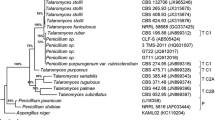Summary
Two strains of Clostridium thermocellum ATCC 27405 and NRCC 2688 demonstrated similar product yields and cellulase activities when grown on solka floc. A sequential culture of C. thermocellum and Zymomonas anaerobia supplemented with cellobiase could produce 1.8 mg/ml of ethanol when grwon on 1% solka floc. Different media were evaluated for their ability to enhance the product and cellulase yields of C. thermocellum grown on cellulose substrates. Ethanol and reducing sugar values of 1.5 and 3.8 mg/ml respectively and an endoglucanase activity of 3 IU/ml were obtained after growth of Clostridium thermocellum in a modified medium containing 1% solka floc. Three different pretreated wood fractions were assessed as substrates for growth. A steam exploded wood fraction gave comparable values to those obtained after growth on solka floc. Sequential cultures of C. thermocellum and Zymomonas anaerobia grown on a 1% steam exploded wood fraction could produce 1.6 mg/ml ethanol after 3 days growth.
Similar content being viewed by others
References
Cooney CL, Wang D, Wang SD, Gordon J, Jiminez M (1978) Simultaneous cellulose hydrolysis and ethanol production by a cellulolytic anaerobic bacterium. Biotechnology and Bioengineering Symposium No. 8. John Wiley and Sons, New York, pp 103–114
Herrero AA, Gomez RF (1980) Development of Ethanol Tolerance in Clostridium thermocellum: Effect of growth temperature. Appl Environ Microbiol 40:571–577
Horton GL, Rivers DB, Emert GH (1980) Preparation of cellulosics for enzymatic conversion. Ind Eng Chem Prod Res Dev 19:422–429
Johnson EA, Madia A, Demain AL (1981) Chemically defined minimal medium for growth of the anaerobic cellulolytic thermophile Clostridium thermocellum. Appl Environ Microbiol 41:1060–1062
Lowry OH, Rosebrough NJ, Farr AL, Randal RJ (1951) Protein measurement with the folin phenol reagent. J Biol Chem 193:265–275
Mandels M, Andreotti R, Roche C (1976) Measurement of saccharifying cellulase. Biotechnology and Bioengineering Symposium No. 6. John Wiley and Sons, New York, pp 21–23
Miller GL (1959) Use of dinitrosalicylic reagent for the determination of reducing sugars. Anal Chem 31:426–428
Miller TL, Wolin MJ (1974) A serum bottle modification of the hungate technique for cultivating obligate anaerobes. Appl Environ Microbiol 27:985–987
Ng TK, Weimer PJ, Zeikus JG (1977) Cellulolytic and physiological properties of Clostridium thermocellum. Arch Microbiol 114:1–7
Ng TK, Ben-Bassat A, Zeikus JG (1981) Ethanol production by thermophilic bacteria: Fermentation of cellulosic substrates by co-cultures of Clostridium thermocellum and Clostridium thermohydrosulfuricum. Appl Environ Microbiol 41:1337–1343.
Ng TK, Zeikus JG (1981) Comparison of extracellular cellulase activities of Clostridium thermocellum LQRI and Trichoderma reesei QM9414. Appl Environ Microbiol 42:231–240
Raabo E, Terkilosen TC (1960) On the enzymatic determination of wood glucose. Scand J Clin Lab Invest 12:402–406
Rogers PL, Lee K-J, Tribe DE (1979) Kinetics of alcohol production by Zymomonas mobilis at high sugar concentrations. Biotechnol Lett 1:165–170
Saddler JN, Chan M K-H, Louis-Seize G (1981) A one-step process for the conversion of cellulose to ethanol using anaerobic microorganisms in mono- and co-culture. Biotechnol Lett 3:321–327
Saddler JN, Brownell HH, Clermont LP, Levitin N (1982) Enzymatic hydrolysis of cellulose and various pretreated wood fractions. Biotechnol Bioeng 24:1389–1402
Sternberg DP, Vijayakuman P, Reese ET (1977) β-Glucosidase microbial production and effect on enzymatic hydrolysis of cellulose. Can J Microbiol 23:139–147
Wang DIC, Cooney CL, Demain AL, Gomez RF, Sinskey AJ (1978) Degradation of cellulosic biomass and its subsequent utilization for the production of chemical feedstocks. Progress Report November 1978, U.S. Department of Energy Contract EG-77-S-02-4198
Weimer PJ, Zeimus JG (1977) Fermentation of cellulose and cellobiose by Clostridium thermocellum in the absence and presence of Methanobacterium thermoautotrophicum. Appl Environ Microbiol 33:289–297
Author information
Authors and Affiliations
Rights and permissions
About this article
Cite this article
Saddler, J.N., Chan, M.KH. Optimization of Clostridium thermocellum growth on cellulose and pretreated wood substrates. European J. Appl. Microbiol. Biotechnol. 16, 99–104 (1982). https://doi.org/10.1007/BF00500734
Received:
Revised:
Issue Date:
DOI: https://doi.org/10.1007/BF00500734




